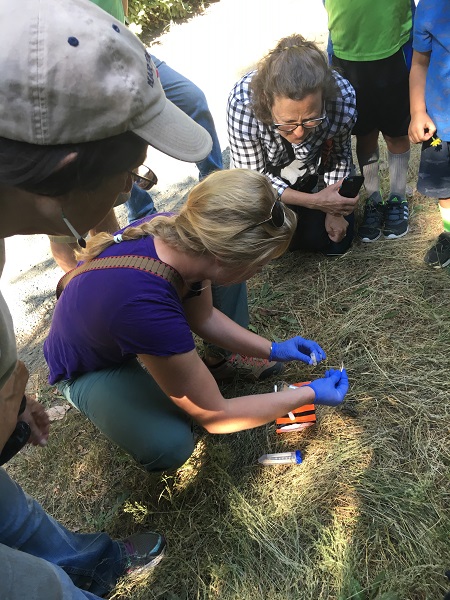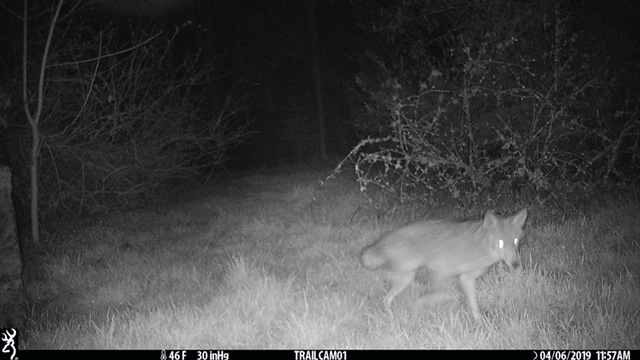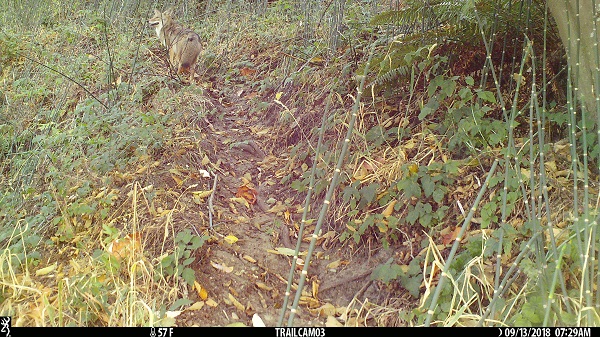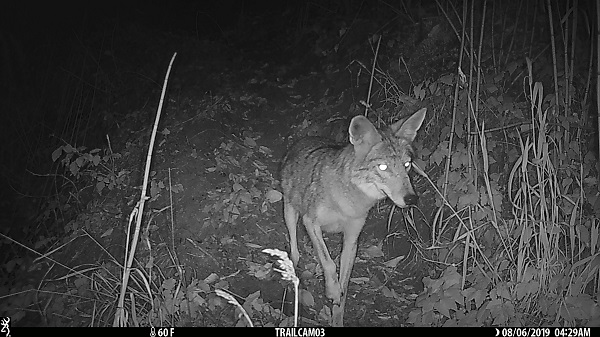Humans usually rely on their eyes to observe nature, but one night each summer, a small group of islanders set out under cover of darkness to witness the wild in a different way.
“At night, our island puts sight to sleep and awakens a symphony of sound—owl calls, bat clicks, deer snorts, rodent rustles, and coyote howls,” says Vashon Nature Center Director Bianca Perla. “On this particular night, instead of squinting our eyes, we ‘squint our ears’—broadcasting sounds into the night and observing what responds.”
Perla is describing the VNC howling survey—one non-invasive way scientists determine how many groups of coyotes live within a specified geographic area. Since 2015, two teams of volunteers led by local scientists have set out just after dark to visit the same 27 locations on Vashon and Maury, where they play recorded coyote howls and/or use human howls to census the local coyote population.
Perla learned the survey technique in the early 1990s while studying wolves in the Idaho and Montana wilderness. She led teams of citizen volunteers into the back country as part of a research project for the San Francisco State Wildlands Studies Program to determine wolf presence and inform reintroduction decisions.
“Coyotes are less discriminating than wolves and will respond to any sort of howl and even the sound of a siren, especially the pups,” Perla says. “Some coyote adults are too smart to respond to a recording, so if we don’t get a response using a recording we follow up with a human howl.”
The survey is carried out all in one night to avoid double counting: Coyotes can move quickly across the island, but not faster than a car full of researchers. On July 10, the teams had five responses to their howls, two included the unmistakable high-pitched, erratic yowls of pups. She adds that coyotes tend not to howl if they are alone, so these surveys likely don’t pick up any single coyotes that are living in the borderlands between packs.
This survey is one of three ways VNC is collecting information about local coyote populations to answer wildlife management questions such as how fast the population is growing, where our coyotes came from, and how they are related. Perla hopes the research will help us be better neighbors to coyotes, learn how to avoid conflicts, and dispel myths—for example, so far howling surveys indicate that island coyote numbers are not growing exponentially but rather grew slowly for a few years until coyote groups covered the full range of the island, and now appear to be holding stable.
In addition to the howling survey, the center manages a DNA scat study and WildCam Vashon—a network of motion-activated “camera traps” that capture photos of wildlife including coyotes.
The scat study, also launched in 2015, began as a diet analysis performed by Vashon High School biology students in conjunction with the Slater Museum of Natural History. Students identified the bones and hair in coyote scat to determine what the animals ate, a diet they found to be 95% vole, a grass-dwelling rodent, which is also a favorite entrée of owls and domestic cats. (Voles have what could be called reproductive superpowers: They reach sexual maturity at 3 to 5 weeks, and females can have up to 12 litters of 3 to 6 young a year!) One coyote can eat up to 1,800 rodents a year.

In 2017, VNC shifted the focus of this study to individual DNA profiles. They partnered with the Prugh Lab at University of Washington, which has developed methods for extracting DNA from animal scat. The first of its kind in the Puget Sound area, Perla hopes the study will offer a more accurate estimate of coyote population and growth, clues about relationships between island coyote groups, and information about territories.
Based on rural coyote data, VNC scientists had estimated local territories at around four-square miles, but recent data from WildCam Vashon—the third pillar of the coyote study—indicates island coyotes may have larger ranges.
“We have been able to identify one coyote we call Bob because he has a noticeably short tail. He lived on the north-end for several years and was a babysitter for a lot of new pups, and then he disappeared,” Perla says. “This year we got him on a camera at Christiansen Creek and thought he had possibly moved south. In July, we had a report of a short-tailed coyote swimming and catching geese at Tahlequah. If this is Bob, it shows he’s using a lot of the island.”

Perla is excited to embark on a related project with researchers at University of Washington, Pt. Defiance Zoo, and others, which will combine DNA scat analysis and wildlife camera data on a regional scale to learn more about ranges, population trends, migration, and differences between urban and rural coyote behavior. Perla is hopeful the collaboration may shed light on the role coyotes are playing in the Puget Sound region.
John Rupp, VNC science adviser and manager of WildCam Vashon, is a biologist and shark expert. He sees parallels between how humans view sharks and coyotes.
“We have been programmed to fear these animals,” he says. “With sharks, it’s this primordial fear of being eaten by the beast, which comes from down deep in our DNA, and the likelihood of is as close to zero as you get. It’s there with coyotes, too—maybe it’s the Big Bad Wolf or a zeal for the expansion of the west and feeling the need to eradicate competitors.”
VNC scientists hope data from its projects will increase knowledge around the island coyote population that may help allay fears, decrease conflict, and improve our ability to live safely with coyotes and experience the benefits of what they bring to natural ecosystems.
It appears from the data that we have a healthy, stable coyote population,” he says, adding that camera evidence indicates no part of the islands is untouched by coyotes. “It seems we’re learning to live in the presence of coyotes.”
WildCam Vashon comprises 17 to 27 cameras monitored by volunteers. (During deer season, hunters helpfully share photos from their locations, nearly doubling the network’s reach.)
Rupp, who assists with the howling survey, enjoys never knowing what he’ll discover next.
“Three years ago, we got a howl response from the Kitsap Peninsula. We played the recording again and, sure enough, they responded again,” he says, “It was remarkable and opened up new questions about the island population: Is there a sense of communication? Are they responding to brethren or angry that someone is nearby? All these things add to the intriguing mystery of the scientific investigation.”

Islander and WildCam operator volunteer JoAnne Hennessey also remembers that night the Kitsap coyotes howled back.
“It’s like live theater, it’s in the moment and you can’t orchestrate that,” Hennessey says. “This year we got an adult howling along with pups and it brings me such joy. It reminds me the world’s bigger than just us.”
Hennessey has lived on Vashon for 25 years and says the last five have been enriched by a new appreciation for those who share the surrounding forest. She feels lucky to have captured cougar, bear, coyote, mink, river otter, and many types of birds on her cameras.
“The wildlife cameras have enhanced our interest in conservation,” she says. “It makes me aware of how we’re all connected and that we can live with them respectfully and keep them wild. You can’t beat that connection—you can’t read it in a book or pick it up on the internet, you have to be there to experience it and it’s phenomenal.”
Contact John Rupp at john.rupp@comcast.net to join WildCam Vashon. For more information on Living with Wildlife please download our new Living with Wildlife Information Packet (created with support from CREOi).

